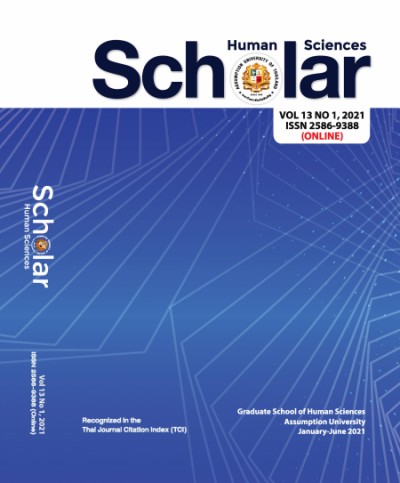The Relationship of Self-Efficacy for Chinese as a Foreign Language Oral Skills and the Use of Indirect Language Learning Strategies for Learning Chinese as a Foreign Language with Oral Skills Achievement of Grade 6 Students in Chinese as a Foreign Language Class at Satit Prasarnmit Elementary School in Bangkok, Thailand
Keywords:
Self-Efficacy, Language Learning Strategies, Chinese Achievement, Foreign Language AcquisitionAbstract
This study aimed to determine the level of self-efficacy for learning Chinese as a foreign language oral skill, the use of indirect language learning strategies for learning Chinese as a foreign language oral skills and Chinese oral skills achievement of Grade 6 students at Satit Prasarnmit Elementary School, and their relationships with each other. Two questionnaires and two sets of listening and speaking tests were used to collect data; one questionnaire was used to determine students’ self-efficacy level and the other was used to determine the use of indirect language learning strategies. Listening and speaking tests were applied to determine oral skills achievement of 96 Grade 6 students who studied Chinese as a foreign language in the academic year 2019-2020 at Satit Prasarnmit Elementary School. To address the objectives of this research, means, standard deviations, and multiple correlation coefficient analysis were applied. The findings indicated that the Grade 6 students at the target school had a very low level of self-efficacy and a low level of indirect language learning strategies (LLSs) use. It was also revealed that self-efficacy, the use of indirect LLSs and students’ oral skills achievement had significant positive relationships with each other.
References
Bandura, A. (1977). Self-efficacy: toward a unifying theory of behavioral change. Psychological Review, 84(2), 191-215. Retrieved from http://garfield.library.upenn.edu/classics1989/A1989U419500001.pdf
Bandura, A. (1986). Social foundation of thought and action: A social-cognitive view. Englewood Cliffs, NJ, US: Prentice-Hall.
Bandura, A. (1989). Human agency in social cognitive theory. American Psychological Association, 44(9), 1175-1184. Retrieved from https://www.uky.edu/~eushe2/Bandura/Bandura1989AP.pdf
Bandura, A. (1994). Self-efficacy. In V. S. Ramachaudran (Ed.), Encyclopedia of human behavior, 4(4), 71-81. New York: Academic Press. Retrieved from https://www.uky.edu/~eushe2/Bandura/Bandura1994EHB.pdf
Jiang, W. (2009). Acquisition of word order in Chinese as a foreign language. Berlin · New York, US: Mouton de Gruyter.
Jiang, X. (2000). A preliminary study of Chinese as a second language learning strategy. Language Teaching and Linguistic Studies, (01), 61-68.
Kassteen, J. (2014). Global trends in foreign language demand and proficiency. ICEF Monitor. Retrieved from http://studenttravelplanningguide.com/global-trends-in-foreign-language-demand-and-proficiency/
Kitikanan, P., & Sasimonton, P. (2017). The Relationship between English Self-efficacy and English Learning Achievement of L2 Thai Learners. LEARN Journal, 10(1), 148-163.
Li, Z. (2016). Study on Chinese learning self-efficacy and learning factors as attribution of Chinese L2 learner, Liaoning University.
Lin, J. (2016). Study on Chinese learning strategies of Thai students. The Central University of Nationalities.
Mohammadi, H., & Alizadeh, K. (2014). An investigation of reliability and validity of strategy inventory for language learning among Iranian university students. International Journal of English Language Teaching, 1(2), 53. Retrieved from http://www.sciedu.ca/journal/index.php/ijelt/article/view/4954
Ooyoung Pyun, D. (2013). Attitudes Toward Task-Based Language Learning: A Study of College Korean Language Learners. Foreign Language Annals, 46(1), 108-121.
Oxford, R. L., & Burry-Stock, J. A. (1995). Assessing the use of language learning strategies worldwide with the ESL/EFL version of the Strategy Inventory for Language Learning (SILL). System, 23(1), 1-23.
Oxford, R., & Nyikos, M. (1989). Variables affecting choice of language learning strategies by university students. The modern language journal, 73(3), 291-300. Retrieved from https://onlinelibrary.wiley.com/doi/abs/10.1111/j.1540-4781.1989.tb06367.x
Oxford, R. L. (1990). Language learning strategies: What Every Teacher Should Know. Belmont, CA, US: Cengage Learning, Inc.
Oxford, R. L. (2003). Language Learning Styles and Strategies: An Overview. GALA, pp. 1-25. Retrieved from http://web.ntpu.edu.tw/~language/workshop/read2.pdf
Oxford, R. L. (2016). Teaching and researching language learning strategies: Self-regulation in context. Routledge.
Wang, C., Kim, D. H., Bong, M., & Ahn, H. S. (2013). Examining measurement properties of an English self-efficacy scale for English language learners in Korea. International Journal of Educational Research, 59, 24-34. Retrieved from https://www.sciencedirect.com/science/article/pii/S0883035513000177
Wang, C., Wang, L., & Li, Y. (2007). Chinese secondary school self-regulated learners of English. In TESOL (Teachers of English to Speakers of Other Languages) 2007 Convention, Seattle, WA.
Wang, X. (2017). 韩国学生汉语学习策略与HSK成绩的相关性研究 [A study on the correlation between Chinese learning strategies and HSK scores of Korean students]. Shandong Normal University.
Zhang, H. (2014). 泰国高中生汉语学习策略现状调查与研究 [An Investigation and research on Chinese learning strategies of high school students in Thailand]. Shaanxi Normal University.




